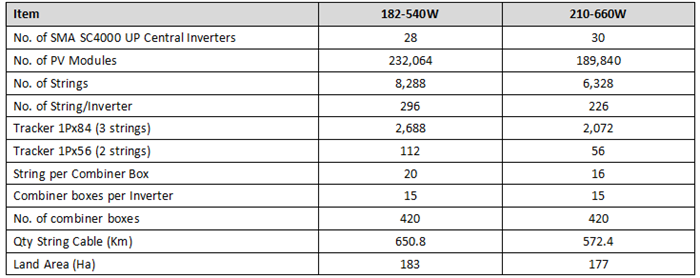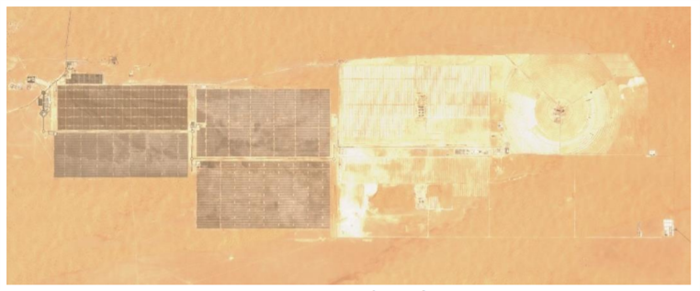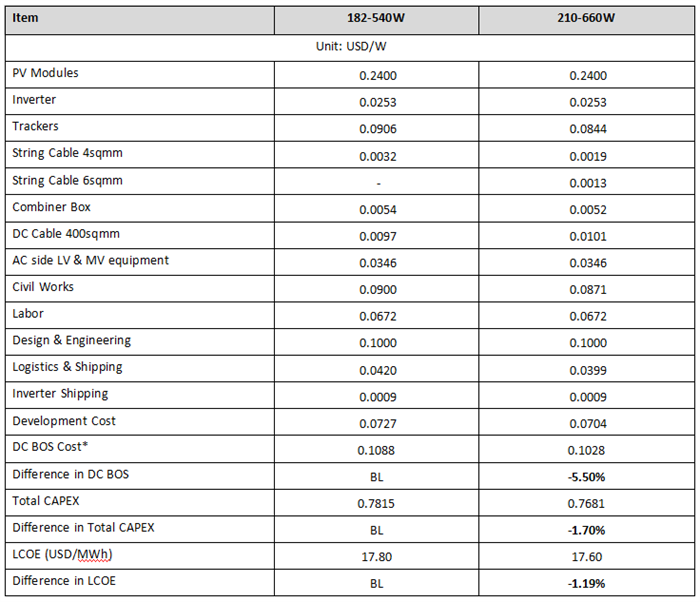The 2022 World Future Energy Summit (WFES) is currently being held in Abu Dhabi, UAE. With the sharing of the same goal as WFES to accelerate sustainability and the global transition to clean energy, Trina Solar and UL have announced the latest study report on the CAPEX and LCOE of the modules 210-660W and 182-540W with different wafer sizes. The report is based on a simulated PV system with a DC capacity of 125MW at two different project locations UAE and Australia.
The study is performed by UL (Underwriters Laboratories), a company with more than 120 years of expertise in bringing clarity and empowering trust to support the responsible design, production, marketing and purchase of the goods, solutions, and innovations.
The study results show that, compared to the plant with 182-540W module, the one with 210-660W module has a lower CAPEX and LCOE in both project locations: In the plant in UAE, the 210-660W module reduced the CAPEX by 1.70% and the LCOE by 1.19%. Similarly, in the plant in Australia, the 210-660W module reduced the CAPEX by 1.50% and the LCOE by 1.32%.
Project description
Location 1: UAE
Location 2: Australia
Module type: Bifacial dual glass 182-540W, Bifacial Dual glass 210-660W
Inverter: Central inverter (SMA Sunny Central 4000 UP)
Method of installation: Nextracker Horizon 1P tracker
Table 1 Bill of Material from 660Wp and 540Wp Array Layout

Table 2 Estimated Annual Irradiation and Meteorological Components for the TMY

Solar PV System in UAE
The UAE 100-MWp solar PV plant is located about 50 km south of the city of Dubai, United Arab Emirates with coordinates of 24.72°N, 55.34°E. It is situated at Mohammed bin Rashid Al Maktoum (MBR) Solar Park, which is one of the world’s largest renewable solar parks with a total capacity of 3000 MW (Figure 1).

Figure 1 Aerial view of MBR Solar Park in UAE
Table 3 lists the CAPEX and LCOE results of the PV system for the two different modules. It shows that the DC BOS cost of the plant with 210-660W module is 5.50% lower than the one with 182-540W module, and the overall CAPEX and LCOE are 1.70% and 1.19% lower, respectively, in comparison with the plant with 182-540W module.
Table 3 Overview of CAPEX and LCOE results of the PV system in UAE.

*DC BOS Cost includes Trackers, String Cables, Combiner Box and DC Cables.
Solar PV System in Australia
Maryvale, New South Wales, Auatralia (32.44°S, 148.93°E) is selected for the study. The town is located in Central West Orana Renewable Energy Zone (REZ) that was formally declared in 2021 as one of five designated clean energy areas, which have been detailed in the NSW Government’s electricity road map and the Australia’s first coordinated renewable energy zone (Figure 2).

Figure 2 Aerial view of the selected site in Australia
Table 4 lists the CAPEX and LCOE results of the PV system with the two modules. It shows that the DC BOS cost of the plant with 210-660W module is 7.70% lower than the one with 182-540W module, and the overall CAPEX and LCOE are 1.50% and 1.32% lower, respectively, in comparison with the plant with 182-540W module.
Table 4 Overview of CAPEX and LCOE results for the PV system in Australia.

Above the results, Trina Solar Vertex modules bring better system values to customers with a lower CAPEX and LCOE. The PV plant using 210-660W module mainly saved the costs of DC BOS, Logistics & shipping and development compared to the one using 182-540W module.
1. In comparison with the conventional modules, the string power of 210 Vertex module can be significantly boosted by 36% thanks to the low-voltage design, which eventually reduces the number of trackers and lower the materials and civil work costs. It is shown in the result that the levelized cost of tracker of 210-660W can be saved by 10% (0.71$ct/W) compared with 182-540W.
2. The innovative vertical packaging of the Vertex module leads to the logistic cost reduction. Within the same 40-foot container, the loading power of 210-660W modules can be increased about 10% compared with the 182-540W module.
3. It is clearly shown that the 210-660W module can greatly reduce the DC BOS cost (including tracker, string Cables, Combiner Box and DC Cables etc.) by more than 7.7% compared with the 182-540W module. Particularly, the innovative design concept of low-voltage and high-string power gives the advantage of using less strings, which requires shorter cable length and reduces the material, wiring and commissioning costs. The total string cable length can be reduced by 12% if using 210-660W modules instead of 182-540W.
